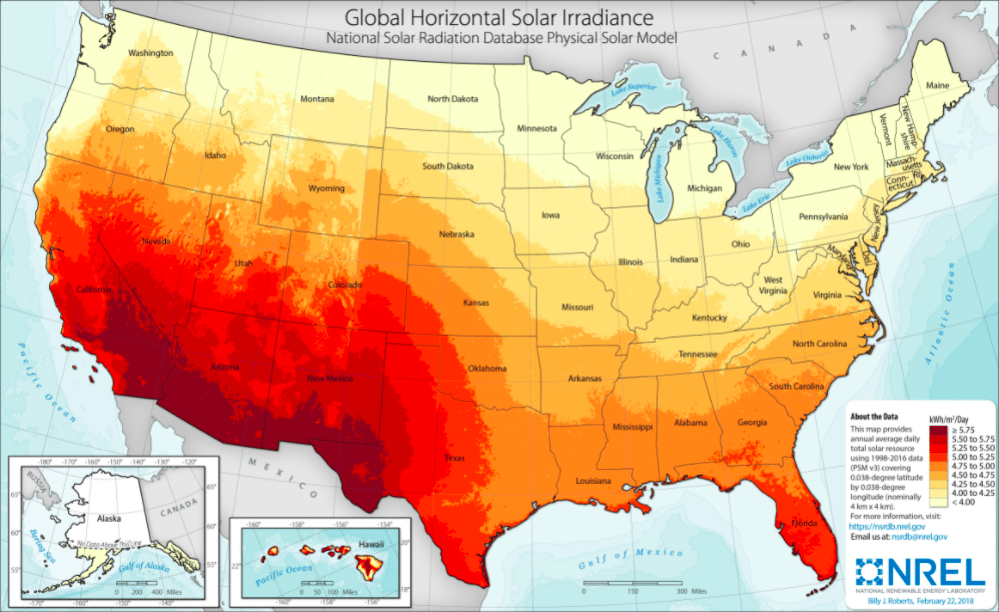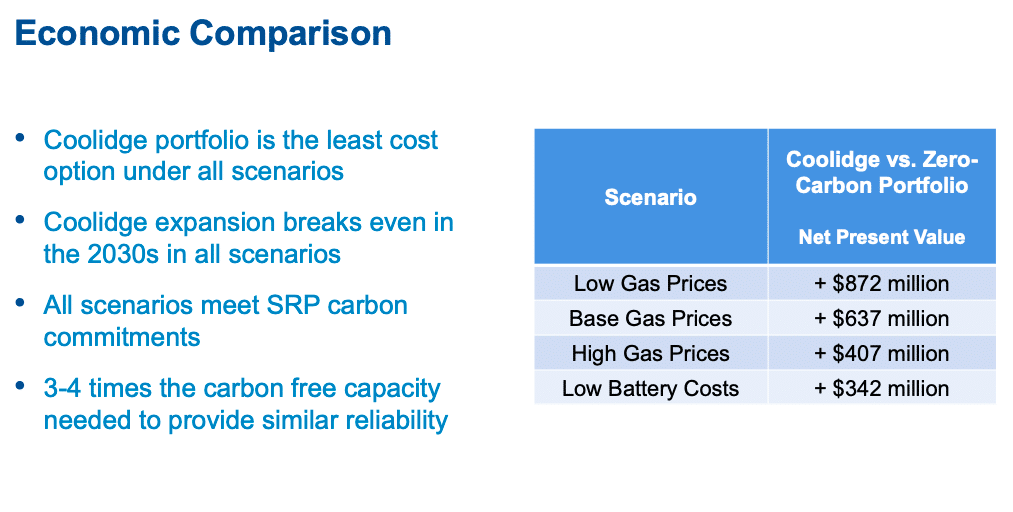Salt River Project board narrowly approves nearly $1 billion gas plant expansion

This post was updated on September 13 to reflect the results of the Salt River Project board vote
The board of directors of the Salt River Project, the third largest public electric utility in the U.S., narrowly voted to approve spending nearly $1 billion to expand a gas power plant in Arizona – though utility executives have provided few details about the proposal to the public or even their own board of directors, and did not use a competitive bidding process to consider other resources.
In an August 24 press release, Salt River Project announced: “If approved by the SRP Board, the expansion of the Coolidge Generating Station would add 820 megawatts (MW) of capacity produced by 16 natural gas turbines.” On the same day, Salt River Project staff requested that the Board of Directors’ Power Committee recommend approval of the gas plant expansion. The presentation shows that Salt River Project expects to spend $830 million to expand the gas power plant, while also allowing for spending above that “for a total cost not to exceed $953 million.”
Clean energy advocates oppose the gas power plant expansion. The Sierra Club and Vote Solar have promoted petitions urging the Salt River Project board to reject the proposal. On Wednesday, representatives of Arizona Interfaith Power & Light and Vote Solar spoke against the gas plant expansion proposal at an event held outside Salt River Project’s headquarters, along with State Senator Juan Mendez, Representative Mitzi Epsten, and Salt River Project board member Randy Miller.
Thank you so much to speakers @SRPconnect board member Randy Miller, Rep. @MitziEpstein, @AZIPL1‘s Rev. Doug Bland, Sen. @mendezforaz, @brianmecinas & @votesolar‘s Yara Marin. Also thank you to @SLBahr + amazing @SierraClubAZ volunteers! #ShameOnSRP #ClimateCrisis pic.twitter.com/ujjlFuppOA
— Stacey Champion (@ChampPR) September 8, 2021
On September 13, the Salt River Project board of directors voted to approve the expansion of the Coolidge Generating Station. Eight directors voted to approve the expansion of the gas plant: Kevin J. Johnson (Division 1), Paul E. Rovey (Division 2), Mario J. Herrera (Division 3), Stephen H. Williams (Division 5), Jack M. White Jr. (Division 6), Deborah S. Hendrickson (Division 8), Robert C. Arnett (Division 9), Mark V. Pace (Division 10).
Six directors voted against approving the gas power plant expansion: Leslie C. Williams (Division 4), Keith B. Woods (Division 7), and all four of the directors elected at-large: Anda G. McAfee, Corey J. Hawkey, Nicholas R. Brown, and Randy J. Miller.
The board also rejected a motion to table the decision for one month so the proposal and data could be analyzed. Both votes followed hours of public comments against the gas power plant expansion from Salt River Project ratepayers, representatives of Arizona Public Interest Research Group, American Lung Association, Southwest Energy Efficiency Project, Sierra Club, and other groups, and elected officials including Phoenix city council member Yassamin Ansari and Arizona State Representative Mitzi Esptein.
“The SRP Board made a nearly billion dollar decision to build 16 gas units with ratepayer money without knowing the projected impact on monthly electricity bills or the total cost over time including fuel and maintenance,” said Arizona Public Interest Research Group Executive Direct Dianne Brown. “The SRP Board, stakeholders, and customers remain in the dark about the inputs used for load forecasts and the specific factors and scenarios contemplated in the Coolidge Expansion Project — which is not the way a utility should conduct business.”
Salt River Project has provided few details about its proposed gas plant expansion
One slide of the August 24 presentation to the Salt River Project Power Committee claims that expanding the gas plant would be cheaper than carbon-free options under four scenarios: “Low Gas Prices,” “Base Gas Prices,” “High Gas Prices,” and “Low Battery Costs.”

The assumptions for those scenarios are not explained in the presentation, and a spokesperson for Salt River Project would not provide the gas prices and battery costs used for the four scenarios. In an email responding to EPI’s inquiry requesting gas prices and battery costs for the four scenarios, the Salt River Project spokesperson wrote:
SRP’s gas and technology pricing is based on subscriptions to third party vendors and updated battery developer bids. Base pricing used for planning on this project is consistent with current NYMEX Henry Hub prices keeping pace with inflation. Batteries are within ranges provided by publicly available sources, and SRP updates the near term with actual projects.
Salt River Project staff have also not provided details about the gas prices and battery cost assumptions in those scenarios to the Salt River Project board of directors, according to board member Randy Miller. Miller, who is also a member of the Power Committee, said he requested that information and more, but that Salt River Project staff have not provided that data to the board, even though the board has been asked to vote on the proposal next week.
Future gas price assumptions play a key role in determining the full costs of a new or expanded gas plant. Bloomberg News reported this week that “natural gas futures soared to a seven-year high” approaching $5/MMBtu, with spot prices in Arizona spiking far higher: “In Phoenix and Los Angeles, so-called spot prices jumped to $30 and $20, respectively, according to a source who asked not to be identified.”
While the costs of operating gas plants depend on volatile gas prices, solar plus battery projects use no fuel.
Salt River Project did not use a competitive bidding process for new resources
Salt River Project’s proposed gas expansion was not the result of a competitive bidding process for new resources, which other utilities in the region have used to determine how to meet expected needs at the lowest cost. UtilityDive reported in June that Xcel Energy Colorado’s all-source competitive solicitation in 2017 “returned a $0.017/kWh bid for wind, a $0.023/kWh bid for solar, and a $0.03/kWh bid for solar-plus-storage.” Wind, solar, and battery costs have continued to decline since then, and solar energy resources in Arizona exceed those in Colorado.

A Salt River Project spokesperson said that staff used an “internal review process” to select the gas expansion proposal, and that they used information from a previous Request for Proposals (RFP); the last RFP Salt River Project conducted appears to have been three years ago, in September 2018. The spokesperson also said that Salt River Project plans to issue an All-Source RFP in the coming weeks:
The selection of natural gas peaking units was informed by recent market pricing that SRP had obtained as follow up to a competitive Request for Proposals (RFP) and a Request for Information (RFI) for wind projects. These competitive processes provided SRP with a good indication of market prices and projects that could be actionable by 2024.
The technology for the Coolidge Expansion Project was selected through an internal review process that considered a variety of factors including cost, operational flexibility, emissions, water use, and experience with the technology.
Based on the results of these RFP and RFI processes, and the internal review process, SRP concluded that the addition of LM6000 turbines at the Coolidge Generating Station is the most prudent and practical approach for addressing the significant near-term capacity needs. SRP will also be issuing another All-Source RFP in the coming weeks for capacity needs beyond the Coolidge Expansion Project.
Salt River Project staff have also not provided details about their “internal review process” and the data and assumptions they used. The utility’s staff told environmental groups that the gas plant expansion proposal relied in part on an analysis from E3 Consulting (Energy + Environmental Economics), but would not provide details of that analysis to the groups. Randy Miller, the Salt River Project board member, said he also requested the E3 analysis, but staff has not provided it to him.
E3 Consulting did not respond to EPI’s inquiries about its work with Salt River Project. E3 Consulting’s website lists Salt River Project as a client.
The executive director of Arizona Public Interest Research Group, Diane Brown, highlighted the lack of public information that Salt River Project has provided about the gas plant expansion, in an op-ed this week:
Particularly disturbing is the lack of public information that exists about the total projected cost including fuel and maintenance; total estimated groundwater consumption – which could affect availability and increase water costs for farmers, businesses, and consumers; and impact on the monthly electricity bills of SRP customers and over what period of time.
The need for more power capacity may be overstated while the options to increase energy efficiency, and renewable resources, such as solar, may be understated.
Without SRP adequately and publicly providing information, it is hard to know the various factors and scenarios they contemplated and whether their forecasts are realistic.
However, due in part to its negative contribution to climate change, we know that new gas builds are becoming obsolete, which means gas plants and units may be left stranded with SRP customers needing to absorb the cost.



